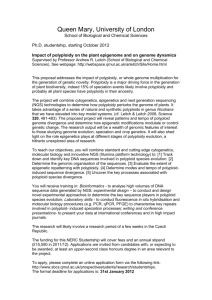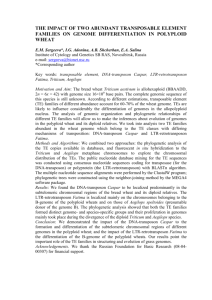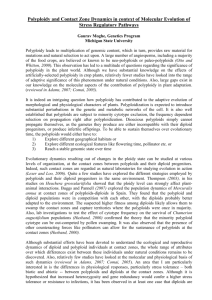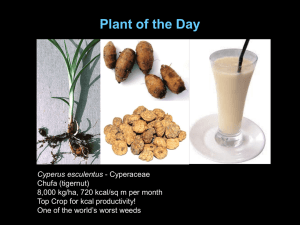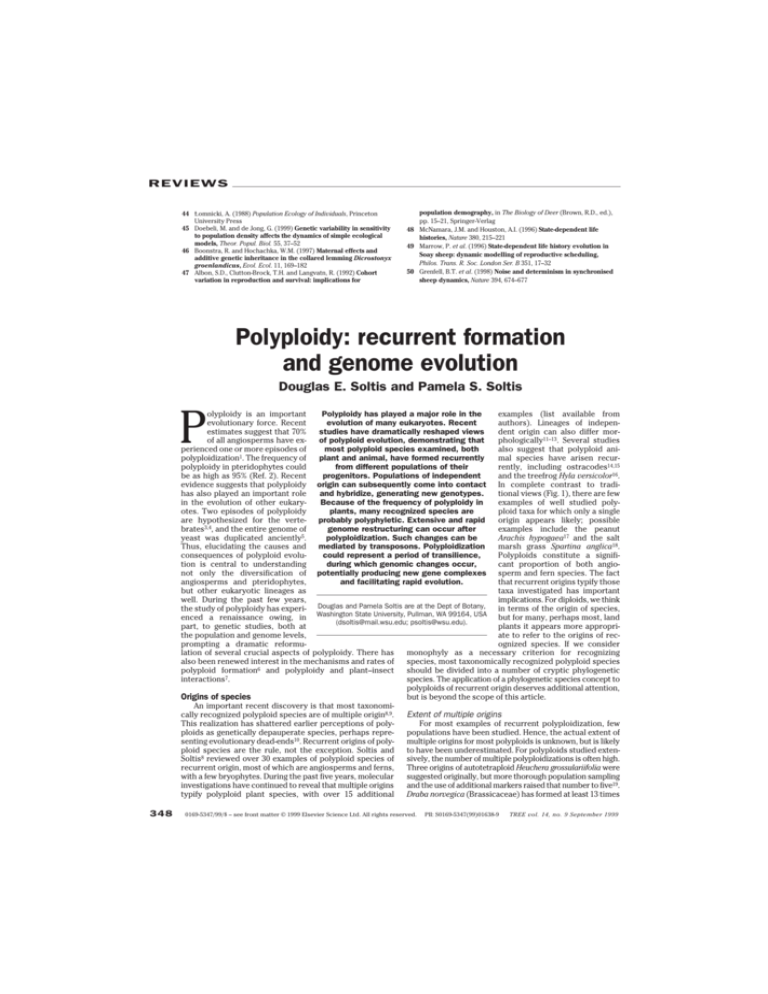
REVIEWS
44 Lomnicki, A. (1988) Population Ecology of Individuals, Princeton
University Press
45 Doebeli, M. and de Jong, G. (1999) Genetic variability in sensitivity
to population density affects the dynamics of simple ecological
models, Theor. Popul. Biol. 55, 37–52
46 Boonstra, R. and Hochachka, W.M. (1997) Maternal effects and
additive genetic inheritance in the collared lemming Dicrostonyx
groenlandicus, Evol. Ecol. 11, 169–182
47 Albon, S.D., Clutton-Brock, T.H. and Langvatn, R. (1992) Cohort
variation in reproduction and survival: implications for
population demography, in The Biology of Deer (Brown, R.D., ed.),
pp. 15–21, Springer-Verlag
48 McNamara, J.M. and Houston, A.I. (1996) State-dependent life
histories, Nature 380, 215–221
49 Marrow, P. et al. (1996) State-dependent life history evolution in
Soay sheep: dynamic modelling of reproductive scheduling,
Philos. Trans. R. Soc. London Ser. B 351, 17–32
50 Grenfell, B.T. et al. (1998) Noise and determinism in synchronised
sheep dynamics, Nature 394, 674–677
Polyploidy: recurrent formation
and genome evolution
Douglas E. Soltis and Pamela S. Soltis
P
examples (list available from
olyploidy is an important
Polyploidy has played a major role in the
authors). Lineages of indepenevolutionary force. Recent
evolution of many eukaryotes. Recent
estimates suggest that 70% studies have dramatically reshaped views
dent origin can also differ morof all angiosperms have ex- of polyploid evolution, demonstrating that
phologically11–13. Several studies
perienced one or more episodes of
most polyploid species examined, both
also suggest that polyploid anipolyploidization1. The frequency of plant and animal, have formed recurrently
mal species have arisen recurpolyploidy in pteridophytes could
from different populations of their
rently, including ostracodes14,15
be as high as 95% (Ref. 2). Recent
progenitors. Populations of independent
and the treefrog Hyla versicolor16.
evidence suggests that polyploidy origin can subsequently come into contact In complete contrast to tradihas also played an important role and hybridize, generating new genotypes.
tional views (Fig. 1), there are few
in the evolution of other eukaryBecause of the frequency of polyploidy in
examples of well studied polyotes. Two episodes of polyploidy
plants, many recognized species are
ploid taxa for which only a single
are hypothesized for the verte- probably polyphyletic. Extensive and rapid origin appears likely; possible
brates3,4, and the entire genome of
genome restructuring can occur after
examples include the peanut
yeast was duplicated anciently5.
polyploidization. Such changes can be
Arachis hypogaea17 and the salt
Thus, elucidating the causes and mediated by transposons. Polyploidization marsh grass Spartina anglica18.
consequences of polyploid evolucould represent a period of transilience,
Polyploids constitute a signifition is central to understanding
during which genomic changes occur,
cant proportion of both angionot only the diversification of potentially producing new gene complexes sperm and fern species. The fact
and facilitating rapid evolution.
angiosperms and pteridophytes,
that recurrent origins typify those
but other eukaryotic lineages as
taxa investigated has important
well. During the past few years,
implications. For diploids, we think
the study of polyploidy has experi- Douglas and Pamela Soltis are at the Dept of Botany, in terms of the origin of species,
enced a renaissance owing, in Washington State University, Pullman, WA 99164, USA but for many, perhaps most, land
(dsoltis@mail.wsu.edu; psoltis@wsu.edu).
part, to genetic studies, both at
plants it appears more approprithe population and genome levels,
ate to refer to the origins of recprompting a dramatic reformuognized species. If we consider
lation of several crucial aspects of polyploidy. There has monophyly as a necessary criterion for recognizing
also been renewed interest in the mechanisms and rates of species, most taxonomically recognized polyploid species
polyploid formation6 and polyploidy and plant–insect should be divided into a number of cryptic phylogenetic
interactions7.
species. The application of a phylogenetic species concept to
polyploids of recurrent origin deserves additional attention,
Origins of species
but is beyond the scope of this article.
An important recent discovery is that most taxonomically recognized polyploid species are of multiple origin8,9. Extent of multiple origins
This realization has shattered earlier perceptions of polyFor most examples of recurrent polyploidization, few
ploids as genetically depauperate species, perhaps repre- populations have been studied. Hence, the actual extent of
senting evolutionary dead-ends10. Recurrent origins of poly- multiple origins for most polyploids is unknown, but is likely
ploid species are the rule, not the exception. Soltis and to have been underestimated. For polyploids studied extenSoltis8 reviewed over 30 examples of polyploid species of sively, the number of multiple polyploidizations is often high.
recurrent origin, most of which are angiosperms and ferns, Three origins of autotetraploid Heuchera grossulariifolia were
with a few bryophytes. During the past five years, molecular suggested originally, but more thorough population sampling
investigations have continued to reveal that multiple origins and the use of additional markers raised that number to five19.
typify polyploid plant species, with over 15 additional Draba norvegica (Brassicaceae) has formed at least 13 times
348
0169-5347/99/$ – see front matter © 1999 Elsevier Science Ltd. All rights reserved.
PII: S0169-5347(99)01638-9
TREE vol. 14, no. 9 September 1999
REVIEWS
in a small area of Scandinavia9,20. Tragopogon miscellus and
T. mirus, two allopolyploid species of goatsbeard, may have
formed as many as 20 and 12 times, respectively, in eastern
Washington and adjacent Idaho (USA) in only the past 60–70
years; multiple polyploidizations have even occurred
within single small towns13,21. Studies of recent allopolyploidy in Tragopogon indicate that multiple origins can
occur frequently over a short timespan and in a small area.
(a)
Single origin
Diploid A
Diploid B
AA
BB
AABB
Close encounters
Recurrent polyploidization involving genetically different diploids can create a series of genetically distinct polyploid populations. Gene flow between polyploid populations
of independent origin might permit recombination and the
production of additional genotypes (Fig. 1). Recent studies
suggest that this occurs in nature. In species of Draba, distinct genotypes of separate polyploid origins co-occur in
the same populations, along with putative recombinants20.
Autopolyploid populations of H. grossulariifolia often comprise a mosaic of genotypes representing separate origins19.
Application of RAPD (random amplified polymorphic DNA)
markers to the allopolyploid Tragopogon species indicates
that populations of separate origin come into contact21.
The short time since the origin of Tragopogon allotetraploids
indicates the rapidity with which polyploid genotypes can
come into contact after their formation.
The arctic flora
On a broad geographical scale, recurrent polyploidization and subsequent interbreeding of genotypes are best
seen in the arctic flora, where diploids and polyploid derivatives exhibit overlapping circumboreal distributions. Traditionally, each polyploid was thought to have formed once;
subsequent migration was considered responsible for
establishing a broad geographical distribution. Genetic data
suggest, instead, that diploid progenitors co-occur repeatedly on a circumboreal scale; polyploid species of Draba
and Saxifraga have formed repeatedly from their diploid
progenitors20,22. Multiple polyploid events from genetically
and morphologically differentiated diploid populations
yield a complex of different genotypes and morphotypes at
the polyploid level. These genotypes ultimately come into
contact and hybridize; subsequent segregation and recombination generate even more genetic and morphological
complexity. This scenario, repeated in numerous lineages,
would explain the well known taxonomic uncertainty
surrounding polyploid complexes in the arctic.
Genome restructuring
Another important recent discovery is the extent and
rapidity of genome reorganization in polyploids (Fig. 2). Modification of parental diploid genomes, once in a common
polyploid nucleus, has until recently been considered minimal. However, chromosome painting, genetic mapping, and
comparative genetics provide evidence for both intra- and
intergenomic reorganization of polyploid genomes; this reorganization can be extensive and occur rapidly. Chromosome
painting (i.e. using chromosome-specific fluorescent markers)
has identified intergenomic chromosomal rearrangements in
polyploids relative to their diploid progenitors: nine such
intergenomic translocations have been detected in allotetraploid tobacco (Nicotiana), five intergenomic translocations in allotetraploid oats Avena maroccana, and ~18 in
allohexaploid Avena sativa23. Furthermore, intergenomic
translocations have been detected in F1 hybrids, demonstrating the rapidity with which such changes can occur when
divergent genomes are placed in a common nucleus23.
TREE vol. 14, no. 9 September 1999
Polyploid
(b)
Multiple origins
Diploid B
Diploid A
AA
A1 A1
Polyploids
AABB
A2A2
BB
A1A1B1B1
A2A2BB
B1B1
B2B2
A2A2B2B2
Hybridization
AA1BB1
A1A2BB1
A2A2BB2
Trends in Ecology & Evolution
Fig. 1. Comparison of (a) traditional view of polyploid formation with (b) new or
revised view. The traditional view envisioned each polyploid species forming only
once, resulting in a new species that was genetically uniform (or nearly so). The new
view suggests that each polyploid species forms over and over again from different
parental genotypes generating a diverse array of polyploid genotypes. Subsequent
hybridization among these polyploid genotypes and recombination result in additional
genetic variability.
Dramatic evidence for genome restructuring in polyploids
comes from comparative genetics24,25. Although gene order
is generally conserved over millions of years within plant
families, genome restructuring also occurs, and this is
more rapid and extensive in polyploids than in diploids24.
Evidence for extensive and rapid genomic change is
available for Brassica via the analysis of naturally occurring
and synthetic polyploids. Chromosome mapping suggests that
the naturally occurring allopolyploid genomes exhibit extensive reorganization compared with their diploid progenitors24,26,27. Extensive genomic change was detected in only a
few generations in synthetic allopolyploid Brassica lines
that were initially completely homozygous28. Furthermore,
the degree of change in the diploid genomes present in the
synthetic allopolyploids agrees with mapping and genetic
data for the naturally occurring polyploids. Therefore, Brassica
provides two important suggestions regarding genomic change
after polyploidization: (1) the more divergent the parents, the
greater the subsequent genomic change in the polyploid; and
(2) the nuclear genome of maternal origin experiences less
change than the paternal contribution. Results for cereals
similarly indicate that rapid genomic changes can occur in
newly synthesized allopolyploids29, and that the extent of
genomic change in a polyploid can be influenced by cytoplasmic–nuclear interactions23,25,30. In a new allopolyploid,
there are adverse interactions between the nuclear genome
contributed by the male parental diploid and both the
nuclear and cytoplasmic genomes contributed by the maternal diploid (in most angiosperms, cytoplasmic organelles
are maternally inherited); genome adjustments must occur
to restore nuclear–cytoplasmic compatibility30.
Genomic maps are presently available for several
grasses, including wheat (Triticum), barley (Hordeum), rye
349
REVIEWS
(a)
Traditional view
Diploid A
Diploid B
x
Maternal parent
Paternal parent
(b)
Revised view
Trends in Ecology & Evolution
Fig. 2. Comparison of (a) traditional view of genomic evolution subsequent to polyploid formation with (b) new or revised view. The classic view of genome evolution
suggested that interactions between the parental genomes of an allopolyploid
were minimal. Recently, it has become apparent that both intra- as well as intergenomic rearrangements occur. (b) In this example, arrows indicate genomic
rearrangements – intragenomic rearrangements are represented by hatched areas
on chromosomes from ‘diploid B’; intergenomic rearrangements are represented by
translocation of ‘black’ or ‘white’ chromosomal segments between the genomes of
‘diploid A’ and ‘diploid B’. The degree of genomic change can also be influenced by
cytoplasmic–nuclear interactions. In a newly formed allopolyploid, there are adverse
interactions between the nuclear genome contributed by the male parental diploid
and both the nuclear and cytoplasmic genomes of the female parental diploid;
genome adjustments must occur to restore nuclear–cytoplasmic compatibility.
Available data suggest that the nuclear genome of maternal origin experiences less
change than does the paternal nuclear genome. Other evidence implicates transposable elements in the genome reorganization that has been detected in polyploids.
(Secale), oats (Avena) and maize (Zea). Whereas the overall ‘big picture’ is one of genome colinearity, chromosome
rearrangements have occurred24. In hexaploid wheat, several intergenomic rearrangements have occurred following
polyploidization31,32, but genome restructuring is not as
extensive as in Brassica. Genome mapping of soybean,
Glycine max, an ancient tetraploid, suggests significant intrachromosomal rearrangement, whereas interchromosomal
recombination has had a minor role33.
Diploidization
In addition to genome restructuring, gene-level changes,
including concerted evolution and gene silencing, also
occur in polyploids8,9,23,25. In some polyploids, chromosomal reorganization and gene silencing (‘diploidization’) are
so extensive that the genome is no longer structured as an
allopolyploid. Paradoxically, the more extensive this
process of diploidization, the more difficult it is to discern.
There was longstanding debate, for example, as to whether
Zea mays was a diploid or an ancient allopolyploid. Genetic
mapping has provided compelling evidence that maize is
350
an allopolyploid, having undergone extensive chromosomal
rearrangement. The maize genome is so extensively rearranged that it is no longer structured as a clear allopolyploid; gene silencing has also occurred34,35. The pattern of
sequence divergence among duplicated genes suggests that
the maize genome is the product of a segmental allotetraploid
that formed ~11.4 million years ago34. Hence, maize is an
excellent example of a partially ‘diploidized’ polyploid.
Although many polyploids, such as maize, have been
referred to as diploidized, detailed genomic studies have
been conducted for few such taxa. However, maize is just
one of a growing number of well documented diploidized
or ‘degenerate’ polyploids. Available data, including genomic
comparisons with rice, suggest that the genome of sorghum
(Sorghum bicolor) is also extensively reorganized and represents a partially diploidized polyploid36. Genomic comparisons also suggest that diploidization has occurred in
polyploid species of sugarcane37 (Saccharum spp.).
Comparative genetic data indicate that ‘diploid’ Brassica
species (n 5 9) are themselves ancient polyploids, with
genomes so extensively reorganized that their polyploid
nature was not obvious. Ancient polyploidy was determined by crossmapping of the genes of the model organism Arabidopsis on to the diploid Brassica genomes. These
studies revealed that ‘diploid’ Brassica genomes consist of
three complete, but rearranged, copies of an ancestral Arabidopsis-like genome24,38 (but see Ref. 39). The data not
only suggest that ‘diploid’ brassicas are diploidized polyploids, perhaps representing ancient hexaploids, but also
indicate that Brassica genomes have evolved through chromosomal fusions and frequent rearrangements. Furthermore, chromosomal fusion events might facilitate further
chromosomal rearrangement because the former telomeres (now internal) are chromosomal weak points.
Polyploidy and transposable elements
Transposable elements (TEs) might facilitate rapid
genome restructuring after polyploidization. Matzke and
Matzke40 argue that polyploidy permits extensive gene
modification by TEs because, by nature, polyploid genomes
contain duplicate copies of all genes; hence, they are well
buffered from the deleterious consequences of transposition. Transposable elements will tend to multiply and be
maintained in polyploids because the additional copies of
genes they maintain will compensate for the loss of altered
expression of genes that might result from TE insertion.
The end result could be higher genomic restructuring in
polyploids compared with their diploid progenitors.
Recent studies suggest the spread of DNA repeat families from one parental diploid genome to the other in
allopolyploid cotton, Gossypium. In cotton, most dispersed
repeat families are restricted to A-genome diploids and are
absent from D-genome diploids. However, in the allotetraploids (which combine the A and D genomes), the
A-genome repeats have spread to the D genome, perhaps
by replicative transposition41.
Transposable elements might also have been the driving force in the evolution of gene silencing mechanisms,
such as methylation and heterochromatin formation,
throughout eukaryotes in general42. These ‘global repression’ mechanisms might have evolved as adaptive
responses to the selfish drive of TEs to expand in number
in a host genome42. Matzke and Matzke40 argue that if TEs
are indeed the primary targets of methylation and other
global repression mechanisms and that polyploids tolerate
transposition because of their duplicate genes, then it
follows that polyploid genomes will not only contain more
TREE vol. 14, no. 9 September 1999
REVIEWS
TEs than diploid genomes, but will also be more highly
methylated. Matzke and Matzke40 suggest that a rough correlation exists. Widespread (‘global’) methylation is found
in vertebrate genomes, which represent several rounds of
polyploidization, as well as in polyploid plant genomes,
which contain a high number of TEs. In contrast, ‘fractional’
(partial), rather than global, methylation occurs in invertebrates and true diploid plants. For example, Arabidopsis,
which is diploid and has a small genome, also has a small
number of TEs, whereas .50% of the maize genome (an
ancient polyploid) is composed of interspersed repetitive
DNAs, primarily nested retrotransposons that insert between
genes43. These retrotransposons are much less abundant,
however, in diploid grasses, such as rice43. The hypotheses
of Matzke and Matzke are provocative; we need more data.
Evolutionary implications
The genetic and evolutionary implications of recurrent
polyploidization and genome reshuffling are obvious in
that both processes represent important sources of
genetic variation. Population-level genetic studies of polyploid plants and animals indicate that polyploidization
should no longer be viewed as a rare event producing a
polyploid species of unique origin and uniform genotype.
Instead, polyploid species can maintain high levels of segregating genetic variation through the incorporation of
genetic diversity from multiple populations of their diploid
progenitors8,13,19,21,22. Polyploid genotypes ultimately come
into contact via migration and hybridize – with subsequent
segregation and recombination generating even more
genetic complexity. Concomitantly, the genome reshuffling
of polyploid genomes is an important additional source of
genetic diversity in polyploid species.
Polyploidy as transilience
Templeton44 suggested that diploid speciation involves
transilience, a period during which the genome is more
amenable to or tolerant of change, such as recombination.
Growing evidence suggests that polyploidy should also be
viewed as transilience. The extensive genomic change
detected in only five generations in synthetic allopolyploid
Brassica28, as well as the chromosomal rearrangements
detected in hybrid Nicotiana23, support this view. The presence of the same chromosomal changes throughout the
populations of a polyploid species suggests that genome
reorganization accompanied speciation, or occurred shortly
thereafter. Species-wide intergenomic translocations have
been detected in several angiosperms, including tetraploid
wheat and tobacco23. Other chromosomal changes detected
in tobacco and wheat are not present in all populations
analysed and apparently represent subsequent chromosomal divergence that occurred in different populations after
speciation.
The chromsomal and gene-level changes reviewed
above are made possible by polyploidization; that is, polyploidy could represent a source of novel evolutionary
processes. Rather than being stable, non-interacting entities, two or more divergent genomes in a common ‘polyploid’ nucleus could facilitate intergenomic interactions,
ultimately resulting in new chromosomal and gene arrangements. Polyploidization might be a source of genomic stress
that facilitates rapid evolution45.
Future directions
The discoveries of the past few years set the stage for a
new series of questions surrounding the genetic and genomic
aspects of polyploid evolution. One set of questions
TREE vol. 14, no. 9 September 1999
involves the evolutionary and ecological consequences of
multiple origins of polyploid species. What is the extent of
gene flow among polyploid lineages of separate origins?
Are different genomic rearrangements detected in populations of separate origins? What are the genetic, as well as
morphological and physiological, consequences of multiple origins? What are the genetic, morphological and physiological consequences of reciprocal maternal parentage in
populations of separate origin?
A second suite of questions involves genome organization. How common is chromosomal and/or genome
restructuring in naturally occurring polyploids? How
rapidly does genome restructuring occur? Is it prevalent in
recently formed polyploids? What is the role of TEs in
genome restructuring and gene silencing? Do autopolyploids and allopolyploids differ in the extent and frequency
of genome restructuring?
Progress in the area of comparative genome organization will be facilitated greatly by large-scale genomic projects already under way for model organisms such as
maize, wheat, Arabidopsis and members of Solanaceae.
These studies will provide fine-scale genomic maps for
polyploid plants including maize, the polyploid brassicas,
potato and tobacco. Such data will provide additional insights into genome evolution in polyploids. It is important,
however, that comparative genetics be applied not only to
crops and close relatives, but also to diploids and their
polyploid derivatives in natural populations.
References
1 Masterson, J. (1994) Stomatal size in fossil plants: evidence
for polyploidy in majority of angiosperms, Science 264,
421–423
2 Grant, V. (1981) Plant Speciation (2nd edn), Columbia University
Press
3 Sidow, A. (1996) Gen(ome) duplications in the evolution of early
vertebrates, Curr. Opin. Genet. Dev. 6, 715–722
4 Spring, J. (1997) Vertebrate evolution by interspecific
hybridization – are we polyploid? FEBS Lett. 400, 2–8
5 Wolfe, K.H. and Schields, D.C. (1997) Molecular evidence for
an ancient duplication of the entire yeast genome, Nature 387,
708–713
6 Ramsey, J. and Schemske, D.W. (1998) Pathways, mechanisms
and rates of polyploid formation in flowering plants, Annu. Rev.
Ecol. Syst. 29, 467–501
7 Thompson, J.N. et al. (1997) Plant polyploidy and insect/plant
interactions, Am. Nat. 150, 730–743
8 Soltis, D.E. and Soltis, P.S. (1993) Molecular data and the dynamic
nature of polyploidy, Crit. Rev. Plant Sci. 12, 243–273
9 Soltis, D.E. and Soltis, P.S. (1995) The dynamic nature of polyploid
genomes, Proc. Natl. Acad. Sci. U. S. A. 92, 8089–8091
10 Wagner, W.H., Jr (1970) Biosystematics and evolutionary noise,
Taxon 19, 146
11 Lowe, A.J. and Abbott, R.J. (1996) Origins of the new allopolyploid
species Senecio cambrensis (Asteraceae) and its relationship
to the Canary Islands endemic Senecio teneriffae, Am. J. Bot.
83, 1365–1372
12 Ownbey, M. (1950) Natural hybridization and amphiploidy in the
genus Tragopogon, Am. J. Bot. 37, 487–499
13 Soltis, P.S. et al. (1995) Genetic variation in Tragopogon species:
additional origins of the allotetraploids T. mirus and T. miscellus
(Compositae), Am. J. Bot. 82, 1329–1341
14 Little, T.J. and Hebert, P.D.N. (1997) Clonal diversity in high arctic
ostracodes, J. Evol. Biol. 10, 233–252
15 Turgeon, J. and Hebert, P.D.N. (1994) Evolutionary interactions
between sexual and all-female taxa of Cyprinotus (Ostracoda:
Cyprididae), Evolution 48, 1855–1865
16 Ptacek, M.B., Gerhardt, H.C. and Sage, R.D. (1994) Speciation by
polyploidy in treefrogs: multiple origins of the tetraploid,
Hyla versicolor, Evolution 48, 898–908
351
REVIEWS
17 Kochert, G. et al. (1996) RFLP and cytogenetic evidence on
the origin and evolution of allotetraploid domesticated
peanut, Arachis hypogaea (Leguminosae), Am. J. Bot. 83,
1282–1291
18 Raybould, A.F. et al. (1991) The evolution of Spartina anglica C.E.
Hubbard (Gramineae): origin and genetic variability, Biol. J.
Linnean Soc. 43, 111–126
19 Segraves, K.A. et al. Multiple origins of polyploidy and the
geographic structure of Heuchera grossulariifolia, Mol. Ecol.
8, 253–262
20 Brochmann, C. and Elven, R. (1992) Ecological and genetic
consequences of polyploidy in arctic Draba (Brassicaceae), Evol.
Trends Plants 6, 111–124
21 Cook, L.M. et al. (1998) Multiple independent formations of
Tragopogon tetraploids (Asteraceae): evidence from RAPD
markers, Mol. Ecol. 7, 1293–1302
22 Brochmann, C. et al. (1998) Molecular evidence for polyploid
origins in Saxifraga (Saxifragaceae): the narrow arctic
endemic S. svalbardensis and its widespread allies, Am. J. Bot. 85,
135–143
23 Leitch, I.J. and Bennett, M.D. (1997) Polyploidy in angiosperms,
Trends Plant Sci. 2, 470–476
24 Gale, M.D. and Devos, K.M. (1998) Plant comparative genetics after
10 years, Science 282, 656–658
25 Wendel, J.F. Genome evolution in polyploids, Plant Mol. Biol. (in
press)
26 Lagercrantz, U. and Lydiate, D. (1996) Comparative genome
mapping in Brassica, Genetics 144, 1903–1910
27 Hu, J. et al. (1996) Linkage group alignment from four independent
Brassica oleracea RFLP maps, Genome 41, 226–235
28 Song, K. et al. (1995) Rapid genome change in synthetic polyploids
of Brassica and its implications for polyploid evolution, Proc. Natl.
Acad. Sci. U. S. A. 92, 7719–7723
29 Liu, B., Vega, J.M. and Feldman, M. (1998) Rapid genomic changes in
newly synthesized amphiploids of Triticum and Aegilops. II.
Changes in low-copy coding DNA sequences, Genome 41, 535–542
30 Gill, B.S. (1991) Nucleo-cytoplasmic interaction (NCI) hypothesis of
genome evolution and speciation in polyploid plants, in
Proceedings of the Kihara Memorial International Symposium on
Cytoplasmic Engineering in Wheat (Sasakuma, T. and Kinoshita, T.,
eds), pp. 48–53, Yokohoma, Japan
31 Nelson, J.C. et al. (1995) Molecular mapping of wheat.
Homoeologous group 2, Genome 38, 516–524
32 Devos, K.M. et al. (1995) Structural evolution of wheat
chromosomes 4A, 5A, and 7B and its impact on recombination,
Theor. Appl. Genet. 91, 282
33 Shoemaker, R., Olson, T. and Kanazin, V. (1996) Soybean genome
organization: evolution of a legume genome, in Genomes of Plants
and Animals: 21st Stadler Genetics Symposium (Gustafson, J.P. and
Flavell, R.B., eds), pp. 139–150, Plenum Press
34 Gaut, B.S. and Doebley, J.F. (1997) DNA sequence evidence for the
segmental allopolyploid origin of maize, Proc. Natl. Acad. Sci.
U. S. A. 94, 6809–6814
35 White, S. and Doebley, J. (1998) Of genes and genomes and the
origin of maize, Trends Genet. 14, 327–332
36 Chen, M. et al. (1997) Microcolinearity in sh2-homologous regions
of the maize, rice, and sorghum genomes, Proc. Natl. Acad. Sci.
U. S. A. 94, 3431–3435
37 Ming, R. et al. (1998) Detailed alignment of Saccharum and
Sorghum chromosomes: comparative organization of closely
related diploid and polyploid genomes, Genetics 150, 1663–1682
38 Lagercrantz, U. (1998) Comparative mapping between Arabidopsis
thaliana and Brassica nigra indicates that Brassica genomes
have evolved through extensive genome replication accompanied
by chromosome fusions and frequent rearrangements, Genetics
150, 1217–1228
39 Quiros, C.F. (1998) Molecular markers and their applications to
genetics, breeding and the evolution of Brassica, J. Jpn. Soc. Hort.
Sci. 67, 1180–1185
40 Matzke, M.A. and Matzke, A.J.M. (1998) Polyploidy and transposons,
Trends Ecol. Evol. 13, 241
41 Wendel, J.F. et al. Genes, jeans, and genomes: reconstructing the
history of cotton, in Plant Evolution in Man-made Habitats
(Proceedings of the VIIth International Symposium of the
International Organization of Plant Biosystematists) (van
Raamsdonk, L.W.D and den Nijs, J.C.M., eds), Rijksherbarium/Hortus
Botanicus, Leiden University, Leiden (in press)
42 McDonald, J.F. (1998) Transposable elements, gene silencing, and
macroevolution, Trends Ecol. Evol. 13, 94–95
43 Bennetzen, J.L. et al. (1998) Grass genomes, Proc. Natl. Acad. Sci.
U. S. A. 95, 1975–1978
44 Templeton, S.R. (1980) The theory of speciation via the founder
principle, Genetics 94, 1011–1038
45 Zhoa, X-P. et al. (1998) Dispersed repetitive DNA has spread to new
genomes since polyploid formation in cotton, Genome Res. 8,
479–492
Current trends
Ð articles of ecological or evolutionary interest in recent issues of other Trends magazines
¥ Variation and evolution of the citric-acid cycle,
Martijn A. Huynen, Thomas Dandekar and Peer Bork
Trends in Microbiology 7, 281Ð291 (July 1999)
¥ Evolution of Wolbachia pipientis transmission dynamics
in insects, Elizabeth A. McGraw and
Scott L. OÕNeill Trends in Microbiology 7, 297Ð302
(July 1999)
¥ Possible stages in the evolution of language capacity,
Ray Jackendoff Trends in Cognitive Sciences 3,
272Ð279 (July 1999)
¥ Nucleotide sequence databases: a gold mine for biologists,
Akhilesh Pandey and Fran Lewitter Trends in
Biochemical Sciences 24, 276Ð280 (July 1999)
¥ The evolution of new structures: clues from
plant cytoskeletal genes, Richard B. Meagher,
352
Elizabeth C. McKinney and Angela V. Vitale Trends in
Genetics 15, 278Ð284 (July 1999)
¥ Ethylene perception and signalling: an evolutionary
perspective, Anthony B. Bleecker Trends in Plant
Science 4, 269Ð274 (July 1999)
¥ Sustainable development: how can biotechnology
contribute? Bernhard Zechendorf Trends in Biotechnology
17, 219Ð225 (June 1999)
¥ Structure and evolution of the extended B7 family,
J. Henry, M.M. Miller and P. Pontarotti Immunology
Today 20, 285Ð288 (June 1999)
¥ Evolutionary change in the functional specificity
of genes, Andreas Eizinger, Benno Jungblut and
Ralf J. Sommer Trends in Genetics 15, 197Ð202
(May 1999)
TREE vol. 14, no. 9 September 1999

